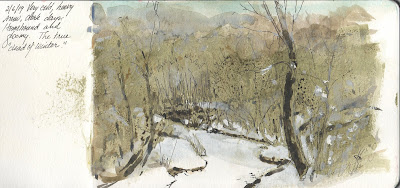Last month was cold. And snowy. And grey. We had dozens of inches of snow here in Des Moines, too. None of that was encouraging for outdoor sketching, so as usual any watercolor landscapes that month were done from the warmth of the studio window. That meant sketches of the creek, mostly, but the cold was sometimes intense enough close to the windows to discourage even that. Regardless, the few sketches I managed are an interesting sketchbook journal of Druid Hill Creek during a frigid February.
All of these were done in a 5x9 watercolor sketchbook. I
primed the pages with dull color (mostly a kind of pale olive) and drew over it. I did a preliminary graphite sketch to establish the composition, then laid on colors thinly using transparent watercolor and gouache keeping the images very soft and vague. Sometimes because the priming layer was a
thin acrylic wash it tended to repel water slightly, causing colors to bead up when applied, which added texture and interest as the paint dried. Finishing touches often meant using ink from technical pens for accentuation and to help establish certain outlines and textures or contours.
February 6. The first week of what was truly the "dead of winter." The creek was snowy but the trees and undergrowth hid much of the ground. With the exception of the grey-blue sky the landscape seemed almost devoid of color. Yet when you spend time looking carefully at a snowy landscape varying colors and values begin to emerge. My goal with this sketch was studying the masses of the woods rather than individual details.
February 14, Valentines Day. As often happens, when skies clear following a big snowstorm temperatures drop. The reason is that without cloud cover surface heat radiates much more. The sketch I made that day was from the same viewpoint as all of the others, but in each there is considerable variation in the composition, where whole sections of the woods are discarded in favor of the painting. My interest here was in the brilliance of light on snow and how the shadow colors and shapes revealed the contours of the banks and surface ice. My other interest here was in contrasting warm and cool colors throughout to bolster the warmth of sunshine and the blueness of shadows without deepening values. Sun on the massed branches in background gives a warmer, more optimistic feel to this one, too. Unlike the sketch above, this was on plain white paper, but in the same sketchbook.
February 17. Only two days later and now the clouds have taken over, considerably more snow has fallen, and the temperatures have stayed frigid. This is painted on another toned page of the sketchbook with scanty darks that beaded up here and there followed by thin applications of titanium white gouache over the darker priming. Warm colors on the foreground trunks and undergrowth helps give depth. The white gouache is tinted with cools and warms to provide more depth and to show snow accumulation along extended branches.
February 24. The cold and snow persisted (and have persisted as of this writing) but inevitably as the sun climbs in the sky the light we receive warms, becomes more yellow. So despite the gloom from a week earlier, clearing skies provided an opportunity to explore the subtle tints of snow and ice in different light. In this one, which was posted not long ago, the paper was again left plain to add brightness, and the tints painted thinly with transparent colors. Varying thickness inking was done using different sizes of technical pen.
If you haven't done daily sketching--be it with pencil, ink, or paint--give it some consideration. Sketching every day provides chances to practice and advance skills. The more practice you get at something the more accomplished you become. Moreover, the sketches are useful as a journal as well as for source material. Fill those sketchbooks.




No comments:
Post a Comment